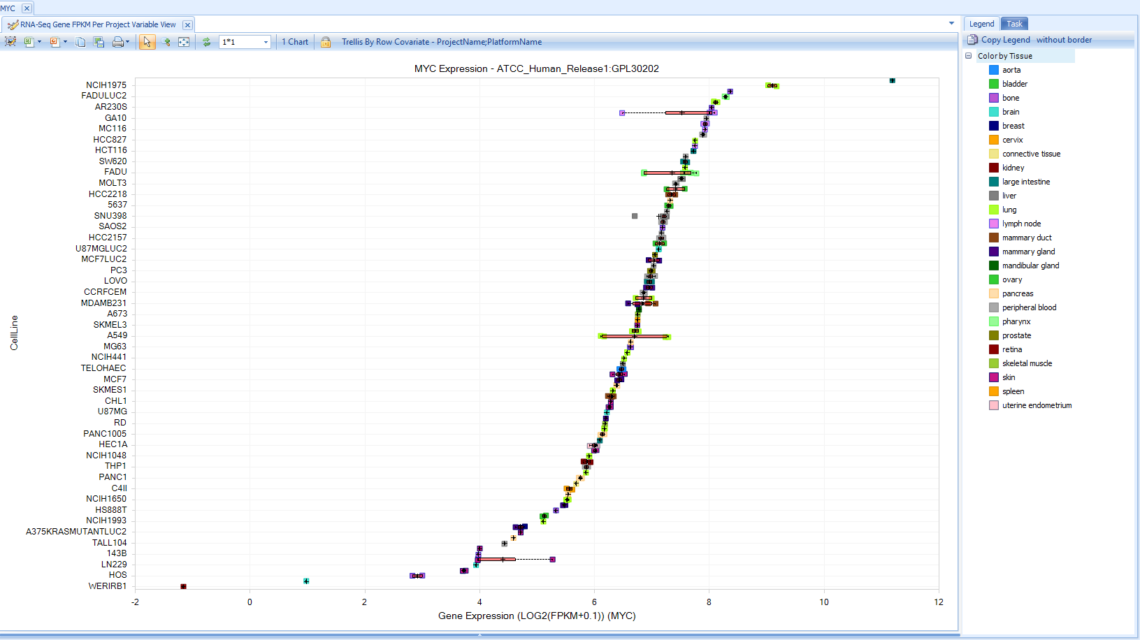Build confidence and efficiency into your preclinical pipeline with traceable and high-quality cell line ‘omics data from a trusted source
If you’re a biologist studying gene function to identify new biomarkers or targets, or testing drug metabolism and toxicity, cell lines are your wingman. They provide the foundation for your experiments, helping you predict clinical response or develop new in vitro models of disease subtypes or patient segments. Yet fundamental to the value of a cell line is understanding its origin, genome and gene expression pattern to help you identify optimal cell lines for your preclinical studies.
Unfortunately, cell line misidentification, genomic aberrations and microbial contamination can compromise the value of cell lines for your experiments (1, 2). A further complication is that current ‘omics data repositories do not contain data on many cell lines. If you’re not studying cancer, you might find yourself lost since most data repositories are missing non-oncology cell line data. You’ll often come up empty-handed when searching for datasets on mouse cell lines, too. This means you need research funds not only to acquire cell lines for your experiments but also to sequence and characterize the genes in those cell lines before you can even begin experiments. This ends up consuming a lot of time and resources, slowing down your drug development research.
Build efficiency into your preclinical pipeline with high-quality cell line ‘omics data
If you depend on cell lines to support your drug development pipeline, we’ve got news that will transform your research.
We’re now offering a new tool that will streamline how you obtain and use cell line ‘omics data to plan and design your preclinical experiments. We partnered with ATCC to establish a database of transcriptomic (RNA-seq) and genomic (whole exome sequencing) datasets from the most highly utilized human and mouse cell lines and primary tissues and cells in ATCC’s collection. These include the most common cell lines, as well as novel cell lines that do not have publicly available transcriptomic data, offering unique data you can’t get your hands on elsewhere. This database is ATCC Cell Line Land.
Cell line ‘omics data from a credible source to ensure reliable research results
ATCC offers credible, authenticated and characterized cell lines, primary tissue and primary cells to enable reproducible research results. The advantage of working with ‘omics data from ATCC cell lines is that the data is derived from cell lines cultured in ISO-compliant conditions. This means the data is reliable and comes from pure, uncontaminated samples. The transcriptome or whole genome is then sequenced from the cell line or tissue, and the resulting ‘omics data is processed and curated using our stringent and rigorous methods for ‘omics data curation, structuring and integration.
“Every dataset we produce can be traced to a physical lot of cells in our bio repository. Since there are no questions about reproducibility and traceability of those materials, you end up with maximum data provenance.”
– Jonathan Jacobs, PhD, Senior Director of Bioinformatics, ATCC
Manually curated, integrated cell line ‘omics data
The ATCC Cell Line Land datasets are processed following the same high-quality data standards we apply to all QIAGEN OmicSoft Lands collections of ‘omics data, which integrate datasets from the largest public ‘omics data repositories using controlled vocabularies and extensive manual curation. Metadata for ATCC Cell Line Land datasets include standard culture conditions, extraction protocols, sample preparation and NGS library preparation. This consistency in curation increases confidence and enables flexible integration for bioinformatics projects, including AI/ML applications. You can use the data to answer your key research questions, explore genes of interest and investigate mutations that may be important to your in vitro experiments (Figure 1).

Figure 1. Box plot showing MYC gene expression across different cell lines in the human cell line collection of ATCC Cell Line Land. This example shows how you can use ATCC Cell Line Land to quickly find cell lines with either high or low expression for a gene of interest.
Tell us, we’re listening: What ATCC cell line data is most valuable to you?
The data in ATCC Cell Line Land is continually growing, with quarterly releases to include ‘omics data on 1000 new samples each year. What’s more, the data grows based on what you, as a researcher, need most. Our team takes your requests to prioritize the cell lines you want added to our ATCC Cell Line Land collection, as well as the type of experimental data you want curated and included in the database. This may include compound treatments with IC50 values or stimulations with cytokine measurements or other parameters. Contact us with your ideas.
Get in touch
Luckily, you no longer need to waste time and money dealing with public portals or taking on the sequencing of cell lines yourself. Speed up cell line characterization and efficiently plan your in vitro testing experiments with high-quality, manually curated cell line ‘omics data from ATCC Cell Line Land. Learn more about how ATCC Cell Line Land and our other integrated ‘omics data collections help you quickly glean insights from public ‘omics data. Your focus is cancer research? Explore how ATCC Cell Line Land is an excellent complement to the Cancer Cell Line Encyclopedia (CCLE) data in QIAGEN OmicSoft OncoLand.
Learn more and request a consultation to explore how ATCC Cell Line Land will streamline your in vitro experiments and accelerate your drug discovery. Read this press release to find out more about our partnership with ATCC.
References:
- Freshney RI. Cell line provenance. Cytotechnology 2002; 39(2):55.
- Didion JP, et al. SNP array profiling of mouse cell lines identifies their strains of origin and reveals cross-contamination and widespread aneuploidy. BMC Genomics 2014;3,15(1):847.

